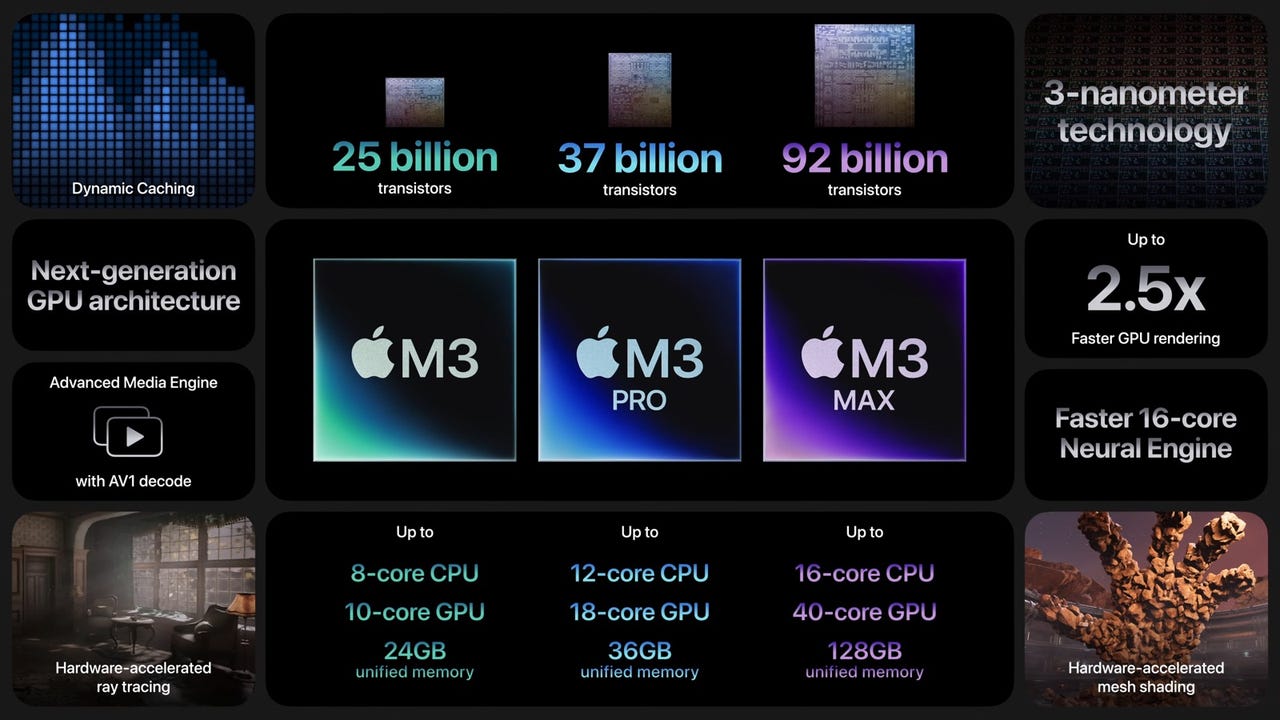
Apple’s new M3 chip key features Apple/ZDNET
It’s hard to believe that the Apple M1 chip was only launched three years ago, with the M1 Pro and M1 Max chips following up a year later, but what’s even harder to believe is that the new M3 series of processors now simply blow away what those processors had to offer.
Also: Everything Apple announced at its October ‘Scary Fast’ event (and what wasn’t unveiled)
This year, Apple simultaneously unveiled the standard M3 chip along with M3 Pro and M3 Max chips, and this allows us to see just how far Apple has come in a few short years.
M3 family overview
The new M3 lineup of chips is built using a 3-nanometer architecture and everything Apple has learned with the previous generations of M-series processors.
These chips feature a CPU which have performance and efficiency cores, a GPU, and a 16-core on-board neural engine. The CPU cores feature improved branch prediction for greater efficiency, and the performance cores have a wider decode and execution engine, while the efficiency cores have a deeper execution engine, all of which boost overall performance and efficiency.
The neural engine, which handles tasks such as on-device machine learning, is up to 60% faster than that found on earlier chips.
M3 neural engine performance Apple
There’s also an improved media engine that offers H.264 and HEVC hardware acceleration, ProRes and ProRes RAW support, and a AV1 decode engine to more efficiently handle video from the likes of YouTube and Netflix.
Also: M3 MacBook Pro with top-of-the-line specs? You’ll be surprised at how far it is under $10,000
Like its predecessor, at the core of everything the M3 chip does is power efficiency, and the M3 CPU and GPU can deliver the same performance as the M1 with half the power.
M3 CPU and GPU power efficiency compared to M1 Apple/ZDNET
Compared to a 12-core laptop PC chip, the M3 CPU can deliver the same performance for only a quarter of the power, while the GPU can do the same for only a fifth of the power.
M3 efficiency versus 12-core PC laptop chip Apple/ZDNET
M3 chip
This is the “base” version of the new Apple Silicon line, and is up to 65% faster than the original M1 chip, depending on which metric is used to measure the performance.
Also: Professionals should buy Apple’s cheapest M3 MacBook Pro for one reason, and one reason only
M3 tech specs
- Up to 24GB unified memory
- 25 billion transistors
- 8-core CPU (4 performance cores, and 4 efficiency cores)
Up to 35% faster than the M1 chips, and 20% faster than the M2 chips - 10-core GPU featuring a next-generation architecture, dynamic caching, mesh shading, and ray tracing
Up to 65% faster than the M1 chips, and 20% faster than the M2 chips
Apple M3 chip Apple/ZDNET
M3 Pro chip
More cores make the M3 Pro chip better suited to those looking for more performance from their hardware, and features more CPU and GPU cores, and more unified memory than the base M3 chip.
Also: What is ProRes and why does Apple keep mentioning it?
M3 Pro tech specs
- Up to 36GB unified memory
- 37 billion transistors
- 12-core CPU (6 performance cores, and 6 efficiency cores)
Up to 20% faster than the M1 Pro chips - 18-core GPU featuring a next-generation architecture, dynamic caching, mesh shading, and ray tracing
Up to 40% faster than the M1 Pro chips, and 10% faster than the M2 Pro chips
M3 Pro chip Apple/ZDNET
M3 Max chip
With the M3 Max, everything is dialed up to the max, making this the perfect chip for those wanting to churn through heavy, complex workloads.
Also: M3 MacBook Pro with top-of-the-line specs? You’ll be surprised at how far it is under $10,000
M3 Max tech specs
- Up to 128GB unified memory
- 92 billion transistors
- 16-core CPU (12 performance cores, and 4 efficiency cores)
Up to 80% faster than the M1 Max chips, and 50% faster than the M2 Max chips - 40-core GPU featuring a next-generation architecture, dynamic caching, mesh shading, and ray tracing
Up to 50% faster than the M1 Max chips, and 20% faster than the M2 Max chips
M3 Max chip Apple/ZDNET




















